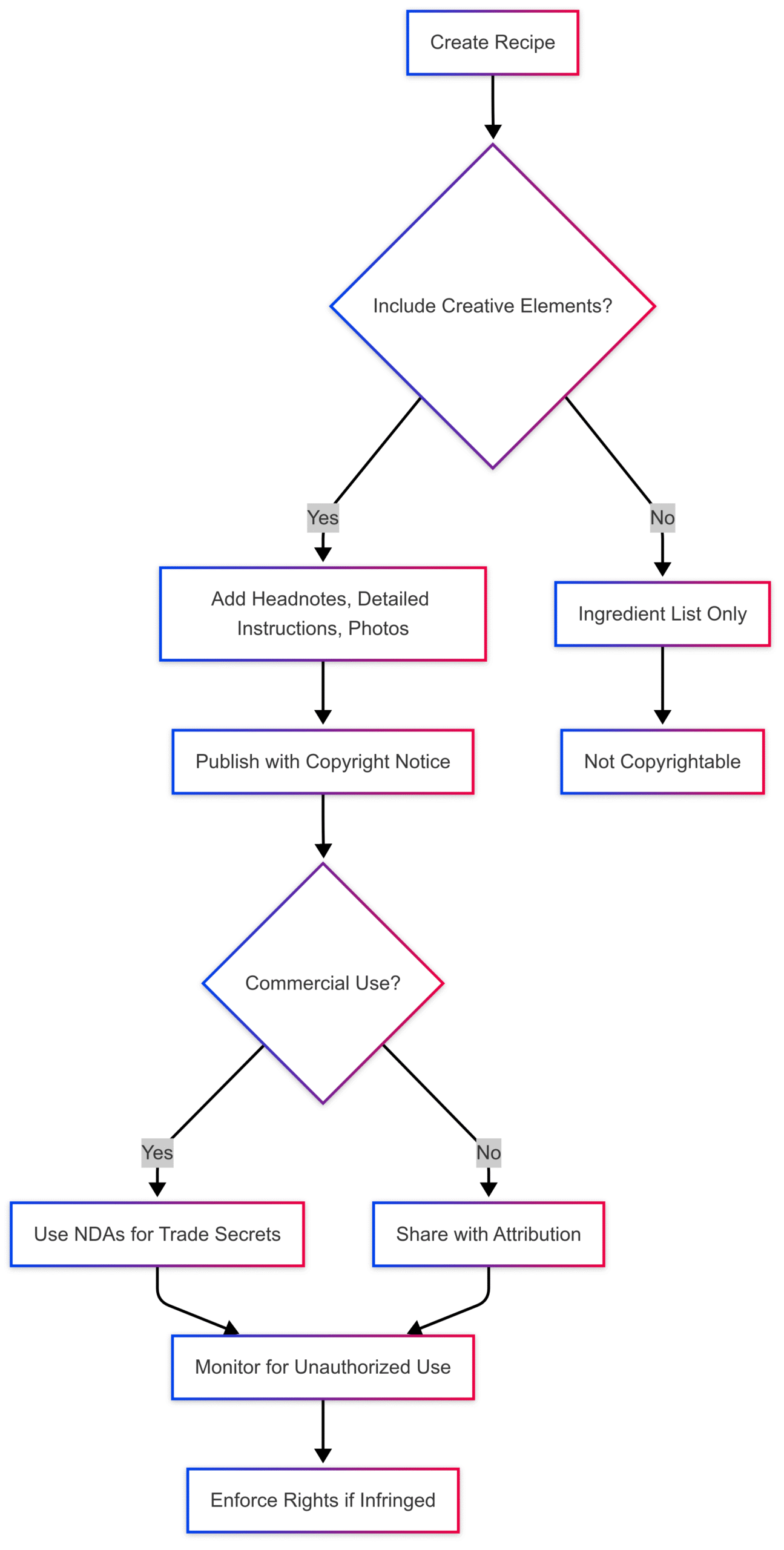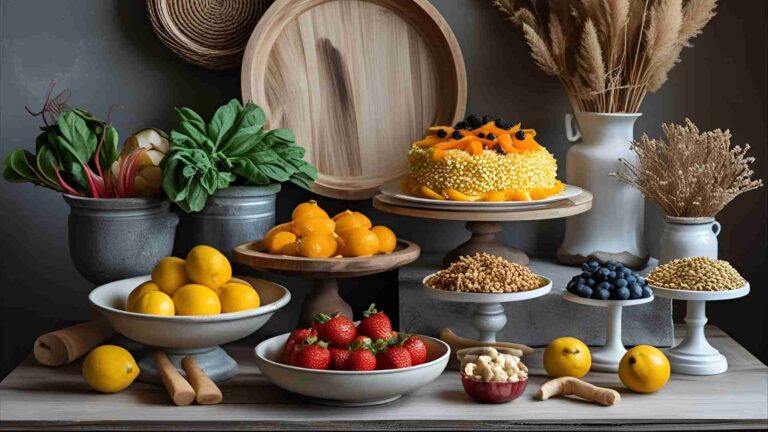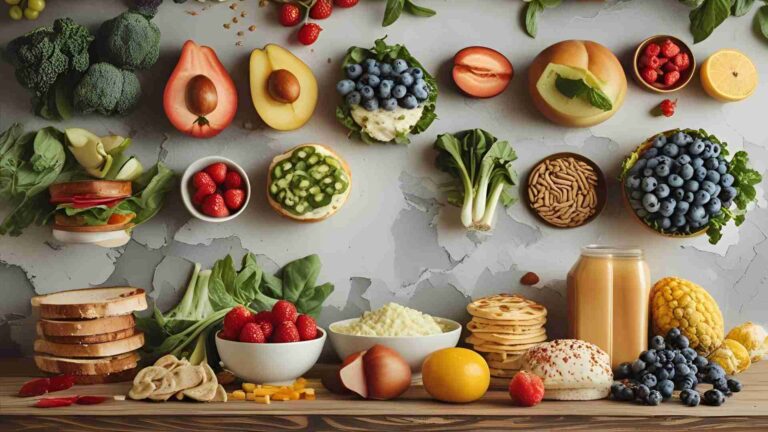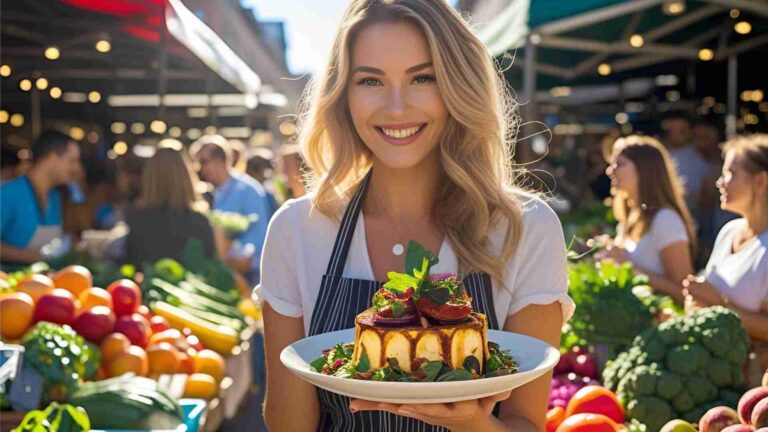Are Recipes and Cookbooks Protected by Copyright
Discover if recipes and cookbooks are protected by copyright law, including what elements can be safeguarded and how to protect your culinary creations.
The culinary world thrives on creativity, from family recipes passed down through generations to innovative dishes crafted by professional chefs. As food blogs, cookbooks, and social media platforms elevate recipes into cultural phenomena, a critical question arises: Are recipes and cookbooks protected by copyright? This article explores the nuances of copyright law as it applies to recipes and cookbooks, addressing common misconceptions, legal protections, and practical steps for safeguarding your culinary creations. We’ll also examine other forms of intellectual property, such as patents, trademarks, and trade secrets, to provide a comprehensive guide for food creators and enthusiasts.
Understanding Copyright Law
Copyright law protects original works of authorship fixed in a tangible medium, requiring three key elements:
- Originality: The work must be independently created with a minimal degree of creativity.
- Human Authorship: It must be created by a human, not a machine or nature.
- Fixation: The work must be recorded in a stable form, such as writing, video, or digital media.
Recipes, at their core, meet many of these criteria. They are created by individuals and often documented in cookbooks, blogs, or videos. However, the application of copyright to recipes is not straightforward due to the idea-expression dichotomy, a foundational principle in copyright law. This principle distinguishes between ideas (not protectable) and their specific expression (protectable). For recipes, this creates a complex landscape.
Can You Copyright a Recipe?
The Ingredient List: Not Copyrightable
A simple list of ingredients, such as “flour, sugar, eggs, butter,” is not eligible for copyright protection. The U.S. Copyright Office’s Compendium (Chapter 313.4(F)) explicitly states that a “mere listing of ingredients or contents” lacks the originality required for copyright. This is because ingredient lists are factual and functional, akin to a phone directory or a list of chemical compounds. Courts, such as in Tomaydo-Tomahdo, LLC v. Vozary (Sixth Circuit), have reinforced this, noting that ingredient lists are “merely factual statements” and thus uncopyrightable.
Similarly, basic instructions like “mix ingredients and bake at 350°F for 30 minutes” are considered functional directions, excluded from copyright under U.S. law (17 U.S.C. § 102(b)). The simplicity of such directions leaves little room for creative expression, making them ineligible for protection.
The Expression: Where Copyright Applies
While ingredient lists and basic instructions are not copyrightable, recipes that include substantial literary expression can be protected. This includes:
- Headnotes: Introductions that provide context, such as the dish’s history, personal anecdotes, or ingredient sourcing tips.
- Detailed Instructions: Creative descriptions of the cooking process, such as “whisk the batter until it sings with airy lightness” versus “mix the batter.”
- Visual and Audio Elements: Photographs, videos, or podcasts accompanying the recipe, which are independently copyrightable as artistic works.
For example, a recipe for chocolate chip cookies might include a headnote about the author’s childhood memories of baking with their grandmother, written in a unique voice. This narrative, along with stylized instructions, qualifies as a literary work under copyright law. However, the copyright only protects the specific expression, not the underlying idea of the recipe itself. Another creator could use the same ingredients and process but must express the recipe in their own words to avoid infringement.
The Three-Ingredient Myth
A common misconception is that changing three ingredients in a recipe makes it “yours.” This is false. Minor tweaks, such as substituting kosher salt for sea salt or adjusting a teaspoon of spice, do not negate copyright protection for the original expression. According to The Recipe Writer’s Handbook by Barbara Gibbs Ostmann and Jane L. Baker, three major changes (e.g., significantly altering the cooking method or primary ingredients) may allow you to claim a recipe as your own, but ethical practice requires crediting the original source. For instance, adapting a recipe for vegan dietary needs might qualify as a significant change, but attribution remains a professional courtesy.
Copyright Protection for Cookbooks
While individual recipes may have limited copyright protection, cookbooks as a whole are protected as compilations. A compilation is a collection of works (e.g., recipes) arranged or selected in a creative manner. The U.S. Supreme Court in Feist Publications, Inc. v. Rural Telephone Service Co., Inc. clarified that a compilation’s copyright protects the “selection, coordination, or arrangement” of its contents, not the individual elements themselves.
For example, a cookbook featuring 100 recipes organized by season, with curated headnotes and thematic photography, is copyrightable due to its creative arrangement. However, the individual recipes within the cookbook may not be protected unless they include substantial literary expression. This means someone could legally reproduce a single recipe from the cookbook (without copying the exact wording or visuals) but could not replicate the entire collection’s structure without permission.
Table: Copyrightable vs. Non-Copyrightable Elements in Recipes and Cookbooks
| Element | Copyrightable? | Reason |
|---|---|---|
| Ingredient List | No | Factual, lacks creative expression |
| Basic Instructions | No | Functional, minimal creativity |
| Headnotes | Yes | Literary expression with creative narrative |
| Detailed Instructions | Yes | Creative description of the cooking process |
| Photographs/Videos | Yes | Artistic works with independent copyright protection |
| Cookbook Compilation | Yes | Creative selection and arrangement of recipes |
Other Intellectual Property Protections for Recipes
Beyond copyright, other forms of intellectual property may apply to recipes, though each has limitations.
Patents
A patent grants exclusive rights to a novel, inventive, and useful invention. In the context of recipes, patents are rarely applicable. The Australian Patents Act 1990, for example, requires an invention to pass an “inventiveness test,” proving it is not a simple mixture of known ingredients (admixture). Only highly innovative recipes, such as those involving unique chemical processes (e.g., molecular gastronomy techniques), might qualify. For instance, a novel method for creating edible foam could be patentable, but a standard cake recipe would not.
Trademarks
Trademarks protect brand identifiers, such as names, logos, or slogans, but not recipes themselves. For example, “Betty Crocker’s Devil’s Food Cake Mix” is a trademarked name, but the recipe for the cake mix is not protected by trademark law. Trade dress, a subset of trademark law, may protect distinctive packaging or presentation, but this is difficult to apply to recipes, as they lack a consistent visual form. Establishing “secondary meaning” (where consumers associate the recipe with a specific source) is challenging, especially for unpackaged dishes.
Trade Secrets
Trade secrets offer protection for confidential information that provides a competitive advantage, such as the recipe for Coca-Cola or KFC’s blend of herbs and spices. Unlike patents or copyrights, trade secrets are not registered; protection relies on confidentiality measures, such as non-disclosure agreements (NDAs) with employees or suppliers. However, trade secrets are vulnerable if the recipe is reverse-engineered or independently discovered. For example, a competitor who replicates a dish through taste-testing does not violate trade secret law unless they obtained the recipe through improper means (e.g., breaching an NDA).
Registered Designs
In Australia, registered designs protect the visual appearance of a product, such as its shape or pattern. This is rarely relevant to recipes but may apply to uniquely designed food products, like the “stand and stuff” taco shell. Most recipes lack a distinctive visual form, making design rights inapplicable.
Practical Tips for Protecting Your Recipes
For food bloggers, cookbook authors, and chefs, safeguarding recipes requires a combination of legal and ethical strategies:
- Incorporate Creative Expression: Elevate recipes beyond ingredient lists by including headnotes, detailed instructions, and multimedia elements. For example, describe the sensory experience of cooking (“the sizzle of garlic in olive oil”) to strengthen copyright protection.
- Develop a Unique Voice: A distinctive writing style makes it harder for others to claim your work. Instead of “bake for 30 minutes,” try “let the oven work its magic until the crust is golden and crisp.”
- Use Copyright Notices: Include a copyright symbol (©) and a notice on your blog or cookbook, such as “© [Your Name]. All rights reserved. For permission to reproduce, contact [email].” This deters unauthorized copying and signals your intent to enforce your rights.
- Foster Ethical Practices: Promote a culture of respect by crediting sources when adapting recipes. For example, note “Inspired by [Source]” or “Adapted from [Cookbook].” This encourages reciprocity within the culinary community.
- Protect Trade Secrets: If you operate a food business, use NDAs to safeguard proprietary recipes. Limit access to sensitive information and document confidentiality measures.
Chart: Workflow for Protecting Recipes

Using Copyright-Protected Recipes Legally
If a recipe includes copyrightable elements (e.g., headnotes, photos), you can still use it in certain ways without infringing:
- Cook the Recipe: Preparing a dish for personal or commercial use does not violate copyright, as the act of cooking does not reproduce the protected expression.
- Share Photos of the Dish: Posting images of the finished dish on social media is permissible, as the dish itself is not copyrighted.
- Summarize and Link: Share your experience cooking the recipe on your blog, summarizing the process in your own words and linking to the original source (e.g., the author’s website or cookbook publisher).
- Sell the Dish: Selling food made from a recipe is legal, as copyright does not extend to the physical product.
However, you cannot reproduce the recipe’s exact wording, photos, or videos without permission. Always credit the source and link to authorized platforms to avoid ethical and legal issues.
Handling Recipe Theft
Content theft is a growing concern for food bloggers and authors. High-profile cases, such as Nagi Maehashi’s accusations against Brooke Bellamy for allegedly plagiarizing recipes, highlight the emotional and financial toll of unauthorized reproduction. If your recipe is copied without permission:
- Contact the Offender: Politely request the removal of the infringing content, providing evidence of your original work.
- Notify the Host: If the offender does not comply, contact the website host or platform (e.g., WordPress, Amazon) and report the copyright violation.
- File a DMCA Claim: Submit a Digital Millennium Copyright Act (DMCA) notice to search engines like Google to have the infringing content removed from search results.
- Seek Legal Advice: In extreme cases, consult a lawyer to issue a cease-and-desist letter or pursue legal action.
Remaining professional and calm is crucial, as aggressive responses can escalate disputes unnecessarily.
Ethical Considerations in Recipe Sharing
Even when copyright does not apply, ethical practices are vital. Attributing sources fosters trust and supports the culinary community. For example, David Lebovitz, a renowned food blogger, emphasizes the importance of crediting inspirations, whether from a cookbook, restaurant, or family recipe. Failing to attribute can harm your reputation and discourage collaboration.
In commercial settings, such as restaurants or catering businesses, using proprietary recipes without permission may violate trade secrets or confidentiality agreements. Employees should respect employer NDAs to avoid legal repercussions.
Special Cases: Cultural and Regulated Recipes
Certain recipes, like Australia’s Anzac biscuits, are subject to unique protections. The Australian Department of Veterans’ Affairs regulates the commercial production of Anzac biscuits, requiring adherence to a specific recipe and shape to use the name “Anzac.” This is an exception, driven by cultural and historical significance, not copyright law.
The Business of Recipes
Recipes are valuable assets in the food industry, which generates billions annually. For businesses like Zina’s Fine Foods, unique recipes differentiate products in competitive markets, such as salad dressings. While legal protections are limited, innovation and branding (e.g., through trademarks) help maintain a competitive edge.
Table: Intellectual Property Options for Recipes
| IP Type | Applicability to Recipes | Protection Scope | Limitations |
|---|---|---|---|
| Copyright | Protects headnotes, detailed instructions, photos/videos | Expression of the recipe, not the idea | Does not cover ingredient lists or basic instructions |
| Patent | Rare, for innovative processes (e.g., molecular gastronomy) | Novel, inventive methods | Not applicable to standard recipes; requires inventiveness test |
| Trademark | Protects recipe names or branding | Brand identifiers (e.g., “Betty Crocker”) | Does not protect the recipe itself; requires secondary meaning for trade dress |
| Trade Secret | Protects confidential recipes (e.g., Coca-Cola formula) | Proprietary information | Vulnerable to reverse-engineering; requires NDAs |
| Registered Design | Protects visual appearance of food products | Shape, pattern of the product | Rarely applicable to recipes; limited to physical products |
Conclusion
Recipes and cookbooks occupy a unique space in copyright law. While ingredient lists and basic instructions are not copyrightable, creative elements like headnotes, detailed instructions, and multimedia can be protected. Cookbooks enjoy copyright as compilations, safeguarding their creative arrangement. Beyond copyright, trade secrets offer a viable option for businesses, while patents and trademarks have limited applicability. By infusing recipes with originality, using copyright notices, and fostering ethical practices, creators can protect their work and contribute to a vibrant culinary community. Whether you’re a home cook, food blogger, or professional chef, understanding these protections empowers you to share your culinary creations with confidence.
Please share these Are Recipes and Cookbooks Protected by Copyright with your friends and do a comment below about your feedback.
We will meet you on next article.
Until you can read, Slow Cooker Hearty Vegetable and Lentil Stew






